The Art of Asking Powerful Questions in Meetings

Introduction
In today's fast-paced business landscape, effective communication is more important than ever. One critical aspect of communication that often gets overlooked is the ability to ask powerful questions. In the context of meetings, powerful questions can be a game-changer, driving deeper conversations, unlocking insights, and fostering a collaborative atmosphere. This article will guide you through the art of asking powerful questions in meetings and the benefits it can bring to your team and organization.
In this comprehensive guide, we'll cover the following aspects of powerful questions:
- The importance of powerful questions and their role in productive meetings
- Different types of questions to help you address various meeting scenarios
- Techniques for crafting and asking effective questions
- Strategies for overcoming challenges associated with asking powerful questions
- Adapting powerful questioning skills to different meeting settings, including remote and hybrid environments
By the end of this article, you will have a deeper understanding of how to ask powerful questions, enhance meeting productivity, and unlock your team's potential. So, let's dive in and explore the art of asking powerful questions in meetings!
The Role of Powerful Questions in Meetings
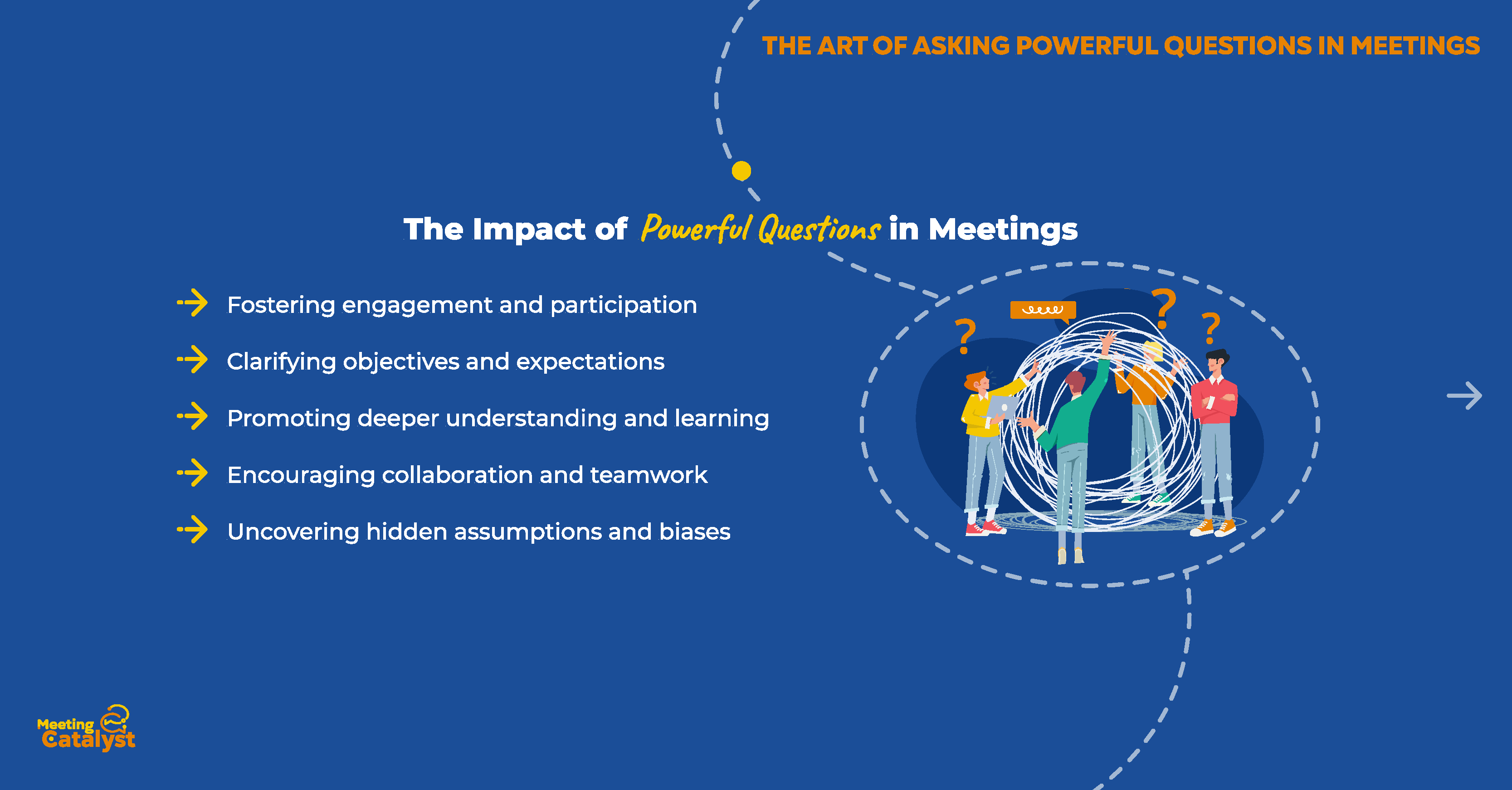
Powerful questions play a pivotal role in driving productive meetings and helping teams achieve their goals. When used effectively, they have the potential to facilitate engagement, collaboration, and innovation among team members. Let's explore the various ways in which powerful questions can impact meetings and bring about positive change:
Fostering engagement and participation: By asking thought-provoking questions, meeting facilitators can stimulate active participation from all attendees. These questions encourage attendees to share their perspectives, ideas, and experiences, ultimately creating a more dynamic and inclusive meeting environment.
Clarifying objectives and expectations: Powerful questions can help to clarify the goals and expectations for a meeting, ensuring that everyone is on the same page. This clarity helps attendees to focus their energy and attention on the most critical aspects of the discussion, leading to more effective decision-making and problem-solving.
Promoting deeper understanding and learning: Asking powerful questions encourages attendees to think more deeply about the issues at hand. This leads to a more profound understanding of the topics being discussed, helping teams to learn from one another and develop new insights.
Encouraging collaboration and teamwork: Powerful questions can foster a sense of collaboration and teamwork among meeting attendees. By creating an environment in which everyone feels empowered to contribute, these questions promote a culture of collective problem-solving and shared ownership over the team's success.
Uncovering hidden assumptions and biases: By challenging conventional wisdom and probing beneath the surface, powerful questions can help teams to uncover hidden assumptions and biases. This process of inquiry can lead to more informed decision-making and help teams to avoid potential pitfalls.
In summary, powerful questions play a crucial role in shaping the success of meetings by fostering engagement, clarifying objectives, promoting deeper understanding, encouraging collaboration, and uncovering hidden assumptions. By mastering the art of asking powerful questions, you can unlock the full potential of your meetings and drive meaningful change within your organization.
Types of Powerful Questions
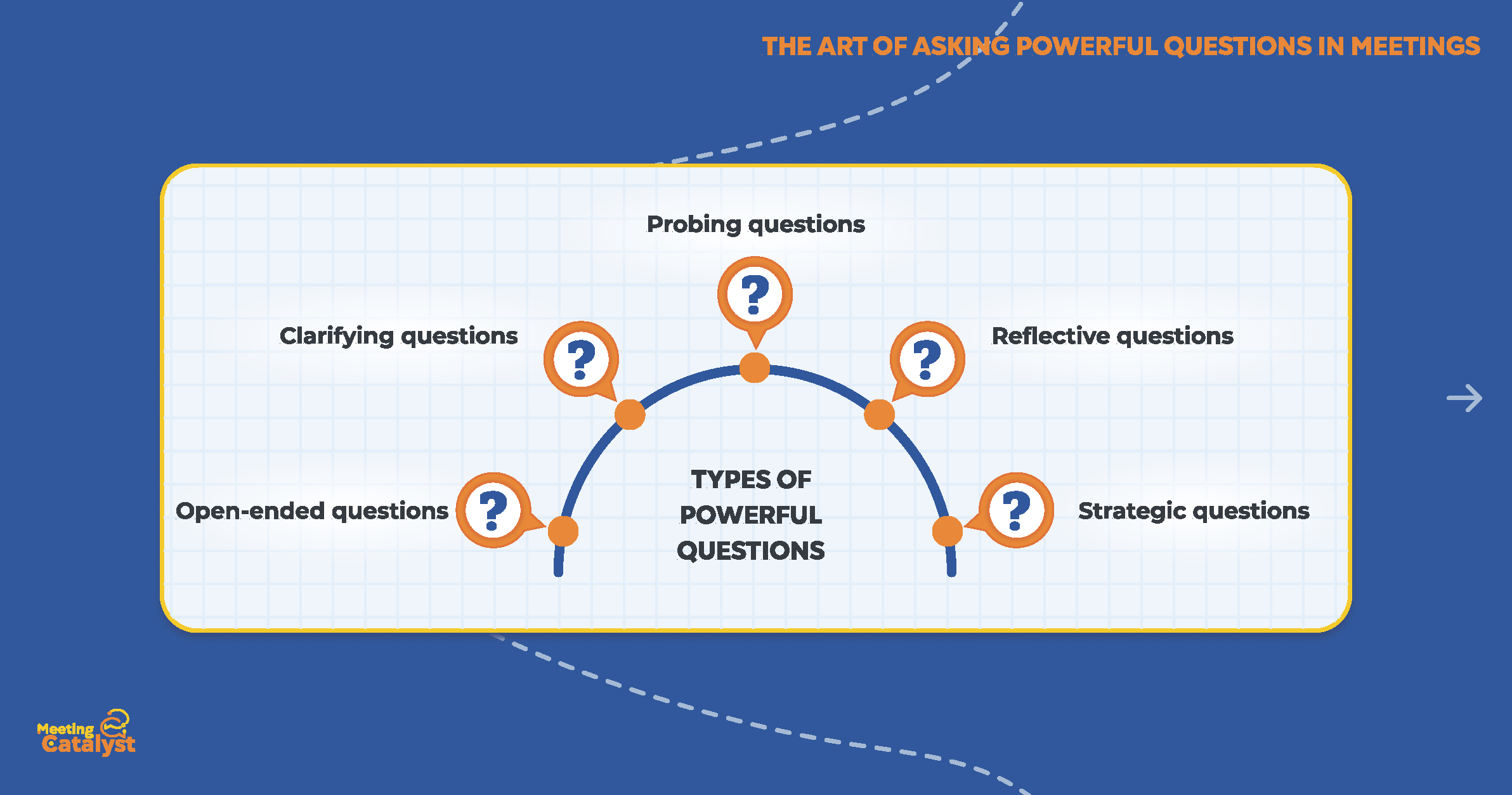
To effectively engage meeting participants and stimulate productive discussions, it's essential to understand the different types of powerful questions that can be employed. Let's explore the various categories of powerful questions and how they can be used to foster a dynamic and inclusive meeting environment:
Open-ended questions: Open-ended questions invite attendees to share their thoughts, ideas, and experiences without limiting their responses. These questions often begin with "What," "How," or "Why" and promote deep thinking and reflection.
- Example: "What do you think is the main challenge we're facing in this project, and why?"
Clarifying questions: These questions are designed to help attendees gain a deeper understanding of the topic at hand. They encourage individuals to explain their thoughts more thoroughly and provide additional context or information.
- Example: "Can you elaborate on how this solution addresses the issue we're discussing?"
Probing questions: Probing questions are used to explore underlying assumptions, beliefs, or biases. They challenge conventional wisdom and encourage attendees to consider alternative perspectives.
- Example: "What assumptions are we making in this situation, and how might they be limiting our thinking?"
Reflective questions: Reflective questions encourage attendees to pause and think about their experiences, feelings, or reactions. These questions promote self-awareness and personal growth, helping individuals to better understand their motivations and decision-making processes.
- Example: "How did you feel when the team reached that decision, and what does that tell you about your values or priorities?"
Strategic questions: Strategic questions focus on the bigger picture and encourage attendees to think about the long-term implications of their actions or decisions. They help teams to align their efforts with organizational goals and consider the broader impact of their work.
- Example: "How does this initiative align with our organization's mission, and what long-term benefits might it bring?"
By understanding the different types of powerful questions and how they can be used to drive engagement and collaboration, you can foster a more productive and inclusive meeting environment. When used effectively, these questions can help your team to develop new insights, overcome challenges, and achieve their goals.
Tips for Crafting Powerful Questions
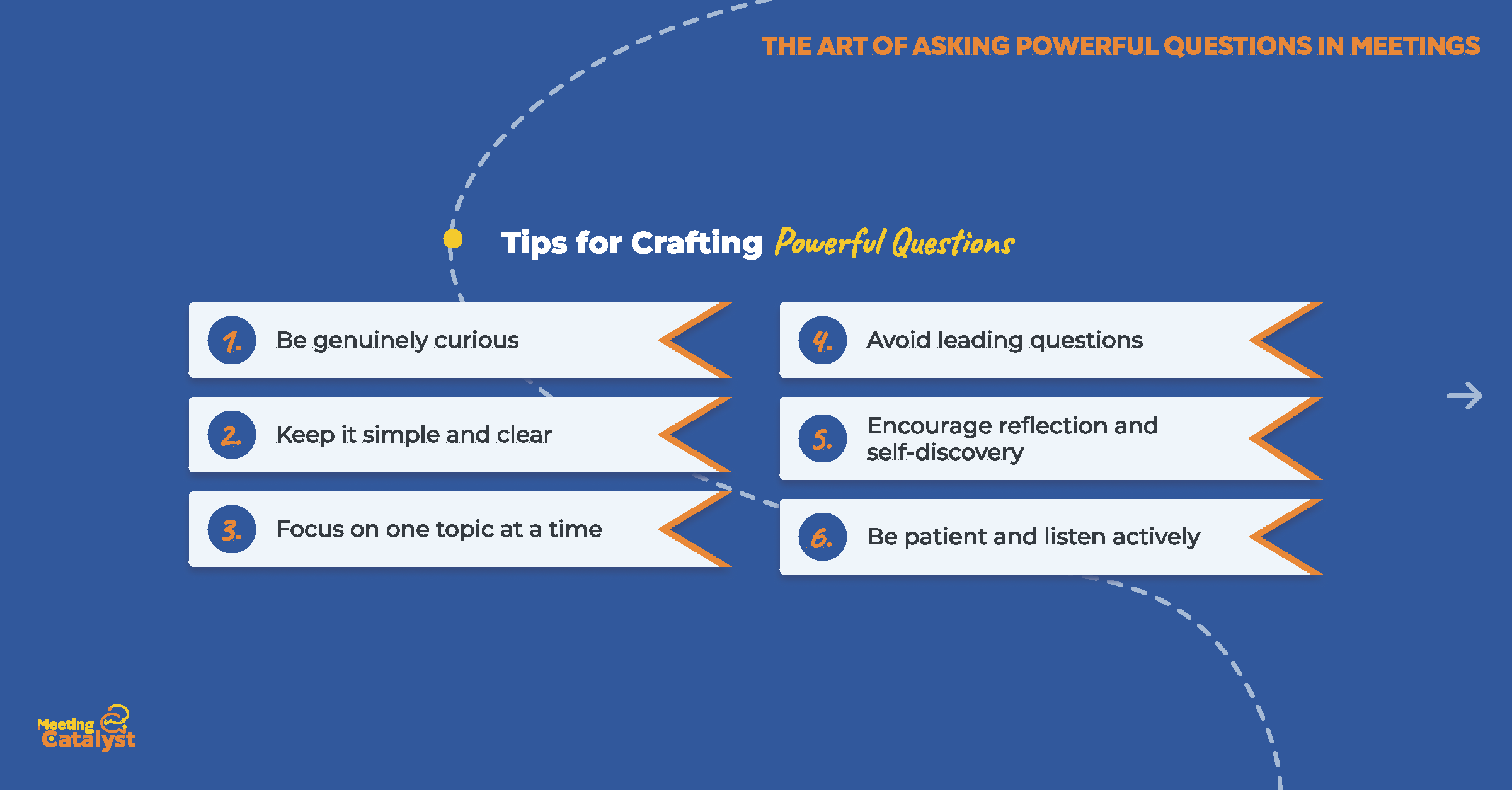
Asking powerful questions is an art, and like any skill, it can be honed with practice and intention. To help you master the art of asking powerful questions in meetings, here are some practical tips to consider:
Be genuinely curious: Approach your questions with a genuine sense of curiosity and a desire to learn from others. This mindset encourages open-mindedness and fosters an atmosphere of trust and collaboration.
Keep it simple and clear: Aim to ask questions that are easy to understand and directly address the topic at hand. Avoid using jargon or complex language, as this can create confusion and hinder productive discussions.
Focus on one topic at a time: Overloading your questions with multiple topics or issues can lead to confusion and derail the conversation. Stick to one central topic or theme for each question to maintain clarity and focus.
Avoid leading questions: Leading questions are those that subtly prompt the respondent to answer in a specific way, limiting their ability to express their true thoughts and opinions. Instead, ask open-ended questions that allow for a range of responses.
- Example: Instead of asking, "Don't you think we should take this approach?", ask, "What are your thoughts on this approach?"
Encourage reflection and self-discovery: Powerful questions often prompt introspection and self-examination. Frame your questions in a way that encourages individuals to reflect on their own experiences and insights, fostering personal growth and learning.
Be patient and listen actively: Give your attendees time to think and formulate their responses, and show that you value their input by actively listening and providing appropriate feedback. This creates a supportive environment where attendees feel comfortable sharing their thoughts and ideas.
By applying these tips and embracing the art of asking powerful questions, you can create a more engaging, productive, and inclusive meeting experience for your team. Remember that practice makes perfect, so continue refining your questioning skills and watch as your meetings transform into powerful opportunities for collaboration and growth.
Active Listening and the Art of Asking Powerful Questions
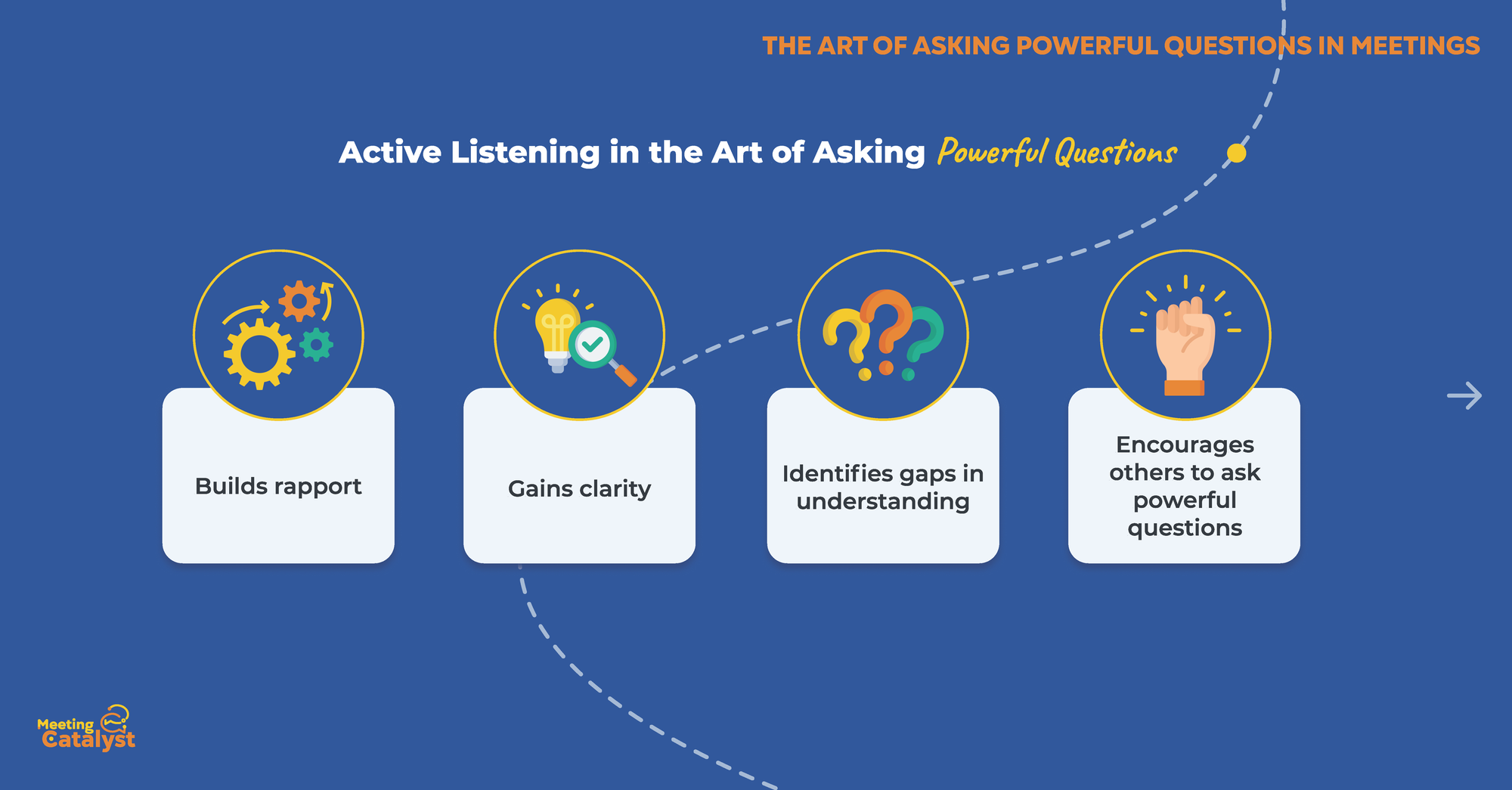
Active listening plays a critical role in the art of asking powerful questions. By truly hearing and understanding the thoughts and opinions of others, you can formulate more meaningful and relevant questions, ultimately enhancing the meeting experience. Here are some key ways in which active listening can support your questioning skills:
Building rapport: Active listening fosters trust and rapport among team members, creating an environment where people feel comfortable sharing their ideas and perspectives. This openness allows for deeper, more insightful questions to emerge.
Gaining clarity: By actively listening to what others are saying, you can better understand the underlying issues, concerns, or ideas being expressed. This clarity helps you ask more targeted and relevant questions, driving the conversation forward.
Identifying gaps in understanding: Active listening enables you to recognize any gaps in your own understanding or areas where further clarification is needed. By asking powerful questions in response, you can fill these gaps and promote a more comprehensive understanding of the topic at hand.
Encouraging others to ask powerful questions: As you model active listening and engage in meaningful questioning, you inspire others to do the same. This creates a culture of inquiry and open dialogue, enriching the overall meeting experience.
To strengthen the connection between active listening and powerful questioning, consider the following strategies:
Paraphrase or summarize: Reflect back what you've heard to ensure you've accurately understood the speaker's message. This also provides an opportunity for the speaker to clarify their point if needed.
Ask for elaboration or examples: Encourage the speaker to expand on their thoughts or provide specific examples to help you better understand their perspective.
Probe deeper with follow-up questions: Use follow-up questions to explore the topic further, uncovering new insights and promoting deeper discussions.
Be fully present and engaged: Show your attentiveness by maintaining eye contact, nodding in agreement, and providing verbal affirmations, such as "I see" or "That's interesting."
By integrating active listening with the art of asking powerful questions, you'll create more effective and engaging meetings that encourage collaboration, problem-solving, and innovation.
Incorporating Powerful Questions in Different Meeting Scenarios
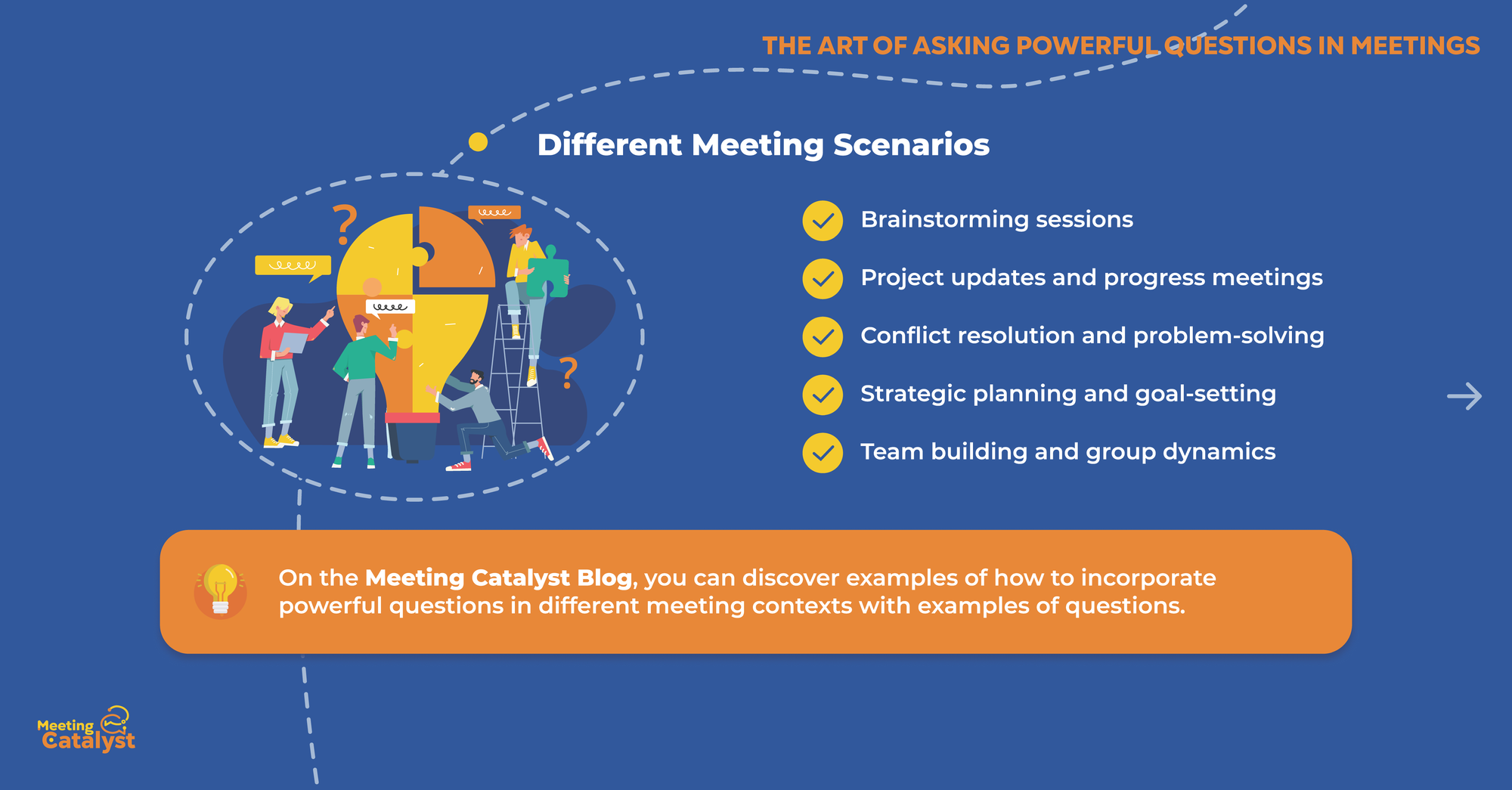
Powerful questions can be applied in various meeting scenarios to encourage critical thinking, stimulate discussion, and uncover valuable insights. Here are some examples of how to incorporate powerful questions in different meeting contexts:
Brainstorming sessions:
- What are the underlying assumptions of this idea?
- How might this idea impact other areas of the project or organization?
- What could be the potential risks or benefits of pursuing this idea?
- Can you think of any alternative solutions or approaches?
Project updates and progress meetings:
- What progress has been made since our last meeting?
- Are there any roadblocks or challenges we should be aware of?
- How can we support each other to overcome these challenges?
- What steps need to be taken to stay on track and meet our goals?
Conflict resolution and problem-solving:
- What do you think is the root cause of this issue?
- How does this conflict affect the team and our overall goals?
- What are some potential solutions to address this problem?
- How can we ensure that this issue doesn't reoccur in the future?
Strategic planning and goal-setting:
- What are our long-term objectives, and how do they align with our mission and values?
- What are the potential barriers to achieving these objectives?
- How can we leverage our strengths and resources to overcome these barriers?
- What specific actions and milestones can we establish to track our progress toward these goals?
Team building and group dynamics:
- How would you describe the current dynamics within our team?
- In what ways can we improve communication and collaboration?
- What unique strengths does each team member bring to the table?
- How can we leverage these strengths to enhance our overall performance?
By incorporating powerful questions into various meeting scenarios, you can facilitate more effective and engaging discussions, ultimately leading to better decision-making, problem-solving, and collaboration.
Overcoming Challenges in Asking Powerful Questions
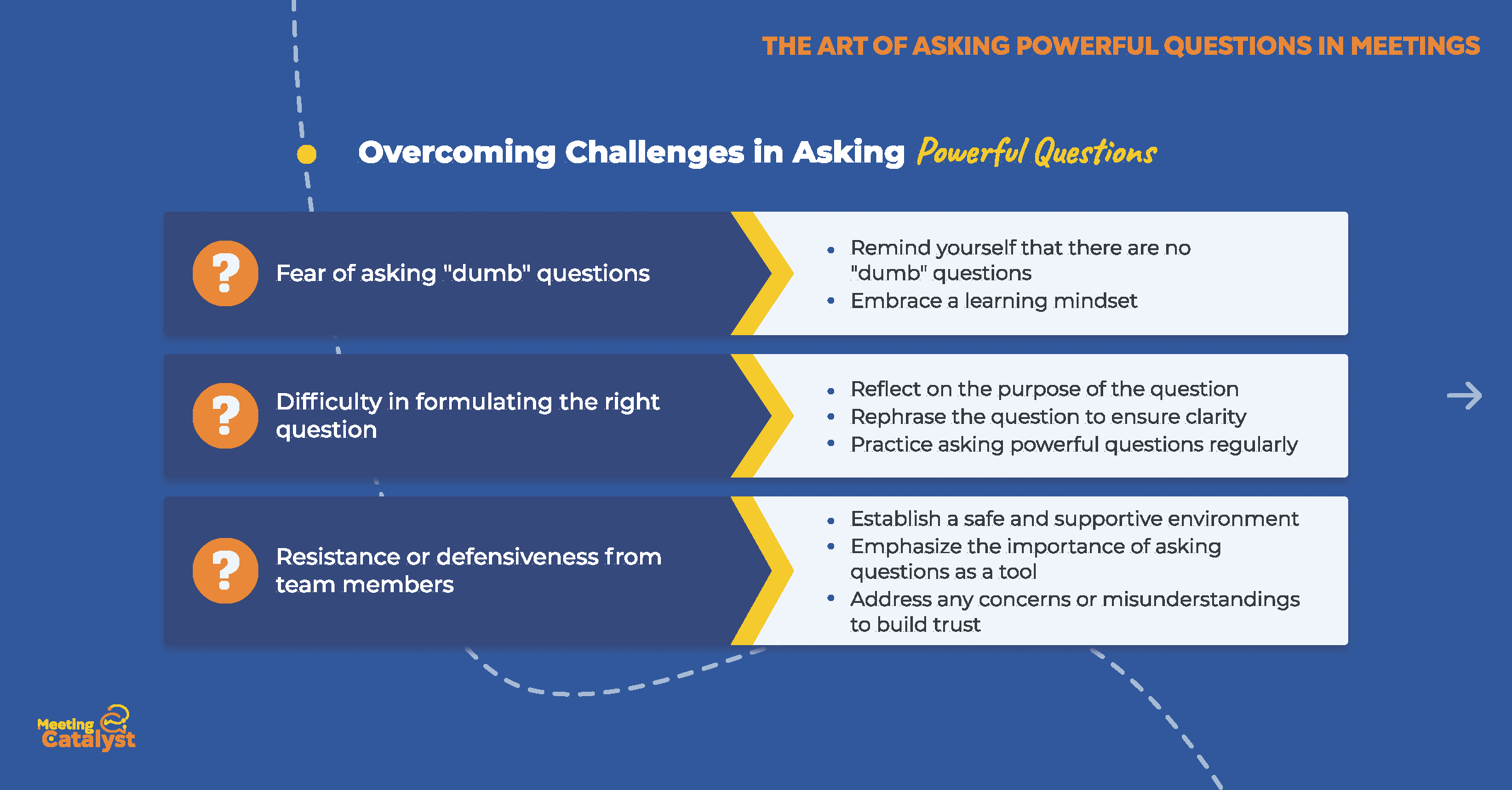
Asking powerful questions can be challenging, especially for those who are new to this skill or facing resistance from team members. Here are some common obstacles and strategies to overcome them:
Fear of asking "dumb" questions:
- Remind yourself that there are no "dumb" questions when it comes to fostering deeper understanding and generating meaningful discussions.
- Embrace a learning mindset and acknowledge that you might not have all the answers.
Difficulty in formulating the right question:
- Take a moment to reflect on the purpose of the question and the desired outcome.
- Consider rephrasing the question to ensure clarity and relevance.
- Practice asking powerful questions regularly to improve your skills.
Resistance or defensiveness from team members:
- Establish a safe and supportive environment where everyone feels comfortable sharing their thoughts and ideas.
- Emphasize the importance of asking questions as a tool for growth and learning.
- Address any concerns or misunderstandings to build trust and rapport.
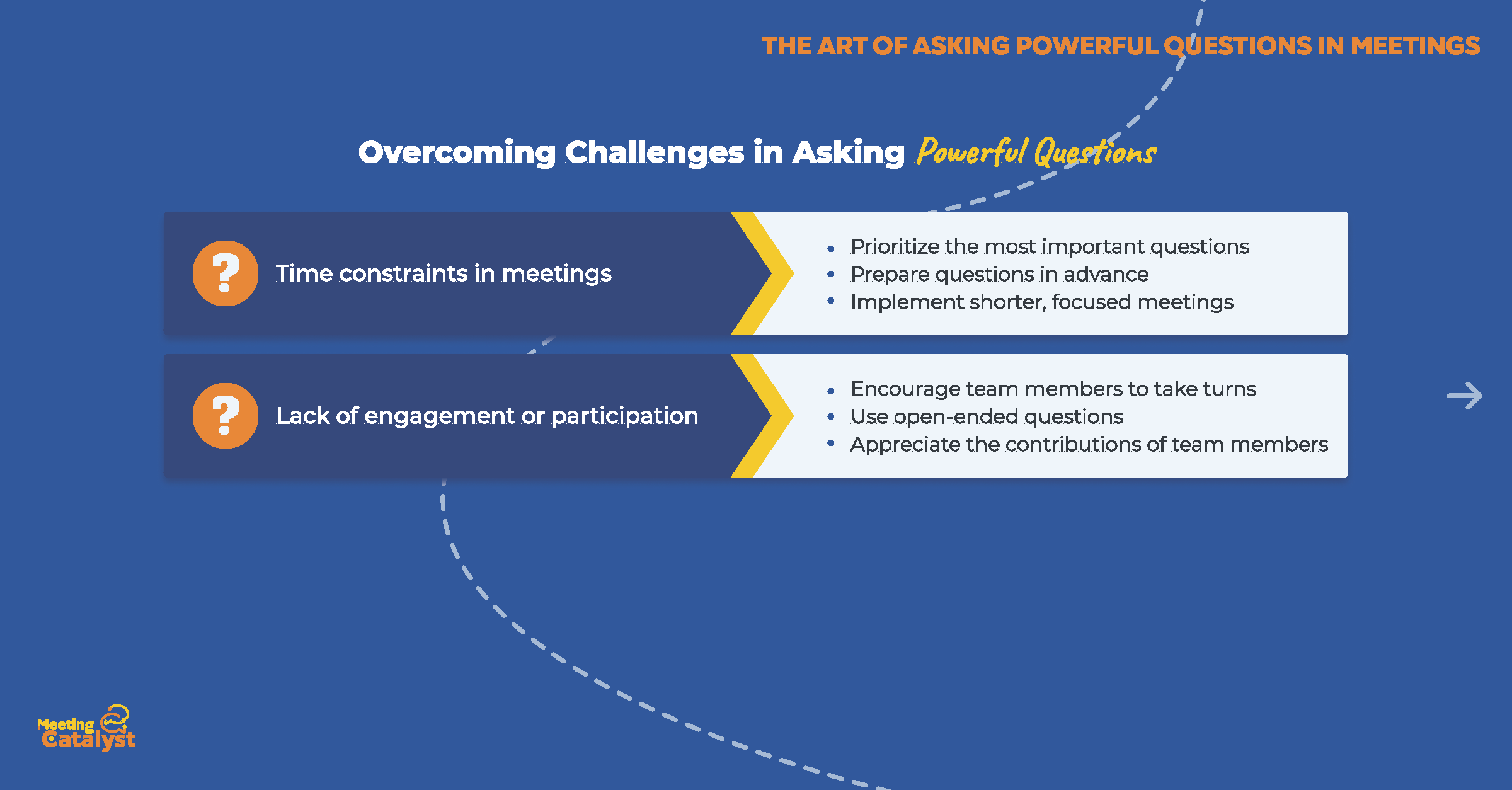
Time constraints in meetings:
- Prioritize the most important questions and allocate sufficient time for discussions.
- Encourage team members to prepare questions in advance, ensuring that valuable meeting time is used effectively.
- Consider implementing shorter, focused meetings dedicated to exploring specific topics through powerful questions.
Lack of engagement or participation:
- Encourage team members to take turns asking and answering questions to foster a sense of ownership and involvement.
- Use open-ended questions that require thoughtful responses, rather than closed-ended questions that can be answered with a simple "yes" or "no."
- Recognize and appreciate the contributions of team members to encourage continued participation.
By addressing these challenges and developing a consistent practice of asking powerful questions, you can enhance the effectiveness of your meetings and foster a culture of curiosity, collaboration, and growth within your team.
Adapting Powerful Questions to Remote and Hybrid Meetings
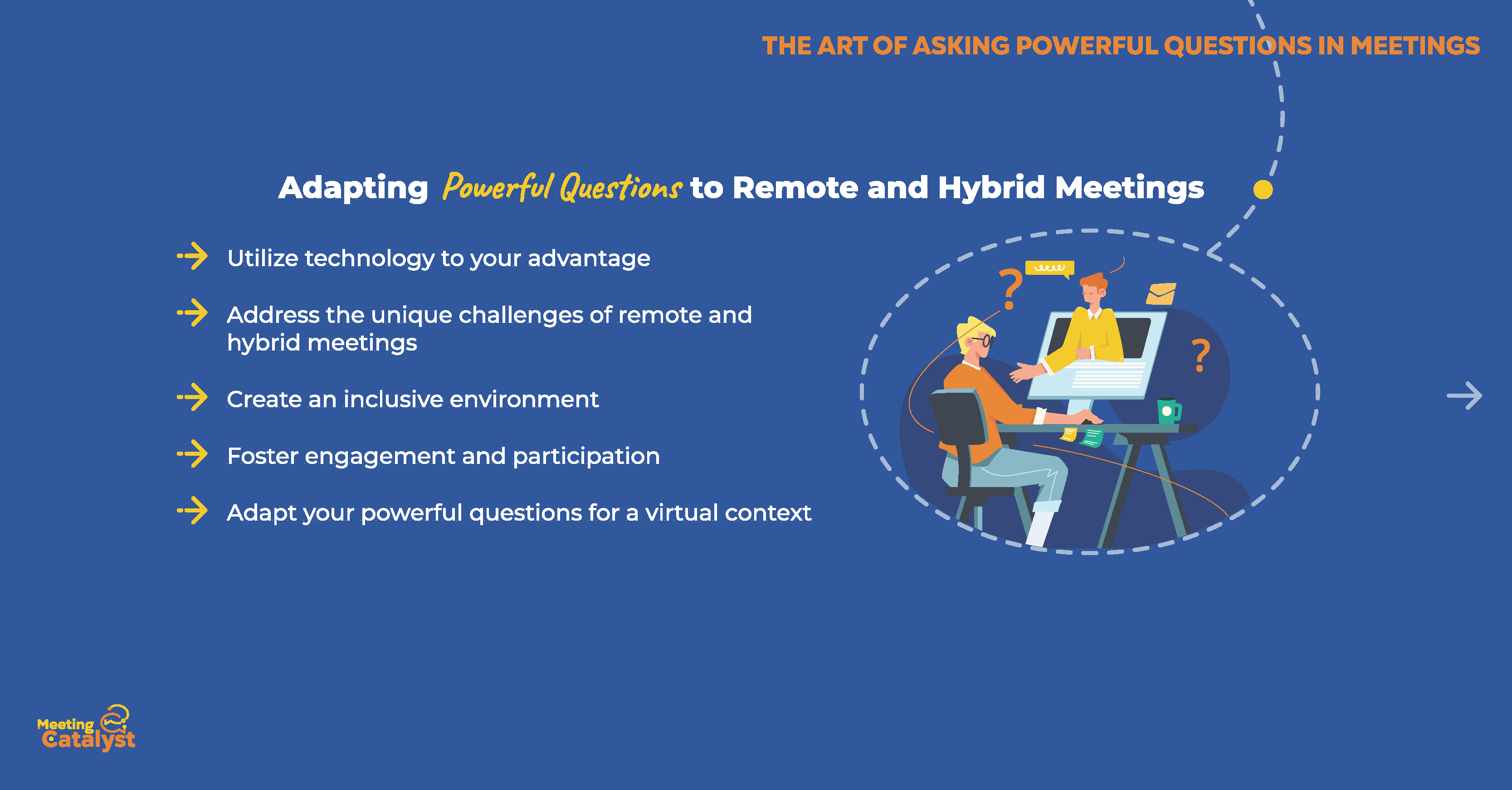
The rise of remote and hybrid work environments has created new challenges for conducting effective meetings. However, the art of asking powerful questions remains as important as ever. Here are some strategies for adapting powerful questions to remote and hybrid meetings:
Utilize technology to your advantage:
- Employ virtual collaboration tools such as whiteboards, breakout rooms, and chat features to facilitate engagement and discussion.
- Encourage participants to use non-verbal reactions (e.g., emojis, hand raising) to express their thoughts and show agreement or disagreement.
Address the unique challenges of remote and hybrid meetings:
- Consider potential time zone differences when scheduling meetings and be mindful of the duration to prevent fatigue.
- Acknowledge and address potential distractions, such as background noise or technical issues, to ensure a focused and productive environment.
Create an inclusive environment:
- Ensure that remote participants have equal opportunities to contribute by asking for their input specifically and providing ample time for them to respond.
- Encourage participants to turn on their cameras when possible, as visual cues can help establish rapport and facilitate more effective communication.
Foster engagement and participation:
- Use icebreakers or warm-up questions to help participants feel comfortable and connected at the beginning of the meeting.
- Assign roles, such as a timekeeper or note-taker, to increase involvement and accountability among team members.
Adapt your powerful questions for a virtual context:
- Be aware of the potential challenges in interpreting tone and non-verbal cues in a virtual setting, and adjust your questions accordingly to avoid misunderstandings.
- Allow for pauses and silence after asking a question to give participants time to process and formulate their responses.
By incorporating these strategies, you can continue to leverage the power of asking questions to drive meaningful conversations, promote collaboration, and enhance meeting productivity, even in remote and hybrid settings.
Conclusion
In conclusion, the art of asking powerful questions in meetings is a crucial skill that can significantly impact the productivity and effectiveness of your team's discussions. By integrating powerful questions into your meetings, you can:
- Foster a more collaborative and engaging environment
- Encourage divergent thinking and innovation
- Enhance problem-solving and decision-making processes
- Create a culture of continuous improvement and learning
As we've seen in the case studies, companies that excel at asking powerful questions are better positioned to navigate complex challenges, develop innovative solutions, and maintain a competitive edge in their industries. By incorporating the tips and strategies discussed in this article, you can elevate your meetings to a higher level of productivity and effectiveness, and ultimately drive better outcomes for your team and organization.
Remember, the key to asking powerful questions lies in your ability to listen actively, be genuinely curious, and create an environment where team members feel comfortable sharing their ideas and perspectives. Embrace the power of inquiry and unlock the full potential of your meetings, both in-person and remote.